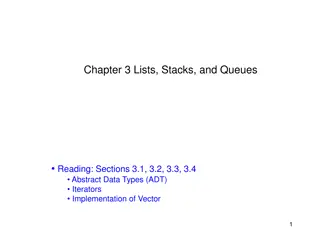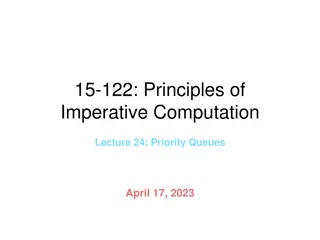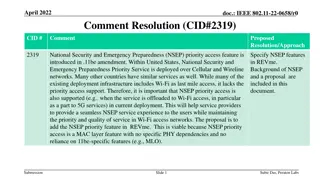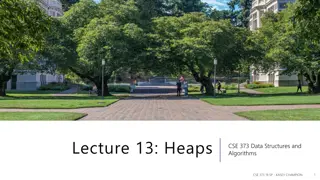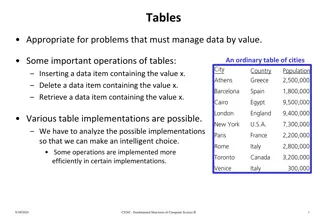Priority Queues: Operations and Implementations
Priority queues are data structures that allow efficient insertion, deletion, and retrieval of elements based on their priority. This information-rich content covers various aspects of priority queues, including ideal times, binomial queues, Dijkstra's algorithm for single-source shortest paths, and run-relaxed heaps. It discusses key operations such as insertion, deletion, finding the minimum, merging sets, and more. Implementations like binary heaps and binomial queues are explored to achieve optimal time complexities for priority queue operations.
Download Presentation

Please find below an Image/Link to download the presentation.
The content on the website is provided AS IS for your information and personal use only. It may not be sold, licensed, or shared on other websites without obtaining consent from the author. Download presentation by click this link. If you encounter any issues during the download, it is possible that the publisher has removed the file from their server.
E N D
Presentation Transcript
Priority Queues MakeQueue Insert(Q,k,p) Delete(Q,k) DeleteMin(Q) Meld(Q1,Q2) Empty(Q) Size(Q) FindMin(Q) create new empty queue insert key k with priority p delete key k (given a pointer) delete key with min priority merge two sets returns if empty returns #keys returns key with min priority 1
Priority Queues Ideal Times MakeQueue, Meld, Insert, Empty, Size, FindMin: O(1) Delete, DeleteMin: O(log n) Thm 1)Meld O(n1- ) DeleteMin (log n) 2) Insert, Delete O(t) FindMin (n/2O(t)) 1) 2) [G.S. Brodal, S. Chaudhuri, J. Radhakrishnan,The Randomized Complexity of Maintaining the Minimum. In Proc. 5th Scandinavian Workshop on Algorithm Theory, volume 1097 of Lecture Notes in Computer Science, pages 4-15. Springer Verlag, Berlin, 1996] Follows from (n log n) sorting lower bound 2
0 3 1 3 2 9 2 0 0 1 Binomial Queues 4 5 7 8 1 0 0 [Jean Vuillemin, A data structure for manipulating priority queues, Communications of the ACM archive, Volume 21(4), 309-315, 1978] 6 5 8 0 7 Binomial tree each node stores a (k,p) and satisfies heap order with respect to priorities all nodes have a rank r (leaf = rank 0, a rank r node has exactly one child of each of the ranks 0..r-1) Binomial queue forest of binomial trees with roots stored in a list with strictly increasing root ranks 3
Problem Implement binomial queue operations to achieve the ideal times in the amortized sense Hints 1) Two rank i trees can be linked to create a rank i+1 tree in O(1) time r r link x y r+1 r y x y x 2) Potential = max rank + #roots 4
Dijkstras Algorithm (Single source shortest path problem) Algorithm Dijkstra(V, E, w, s) Q := MakeQueue dist[s] := 0 Insert(Q, s, 0) for v V \ { s } do dist[v] := + Insert(Q, v, + ) while Q do v := DeleteMin(Q) foreach u : (v, u) E do if u Q and dist[v]+w(v, u) < dist[u] then dist[u] := dist[v]+w(v, u) DecreaseKey(u, dist[u]) n x Insert + n x DeleteMin + m x DecreaseKey Binary heaps / Binomial queues : O((n + m) log n) 5
Priority Bounds Run-Relaxed Heaps [Driscoll, Gabow, Shrairman, Tarjan 88] 1 [Brodal 96] [Brodal, Lagogiannis, Tarjan 12] Binomial Queues [Vuillemin 78] 1 Fibonacci Heaps [Fredman, Tarjan 84] 1 Insert 1 Meld 1 1 - 1 Delete DeleteMin log n log n log n log n log n log n log n log n DecreaseKey log n 1 1 1 Amortized Worst-case Dijkstra s Algorithm O(m + n log n) (and Minimum Spanning Tree O(m log* n)) 6 Empty, FindMin, Size, MakeQueue O(1) worst-case time
Fibonacci Heaps [Fredman, Tarjan, Fibonacci Heaps and Their Use in Improved Network Algorithms, Journal of the ACM, Volume 34(3), 596-615, 1987] 3 3 2 0 4 7 1 0 6 5 F-tree heap order with respect to priorities all nodes have a rank r {degree, degree + 1} (r = degree + 1 node is marked as having lost a child) The i th child of a node from the right has rank i - 1 Fibonacci Heap forest (list) of F-trees (trees can have equal rank) 0 7 7
Fibonnaci Heap Property Thm Max rank of a node in an F-tree is O(log n) Proof r 3. By induction subtree size is at least 2 r/3 A rank r node has at least 2 children of rank ( in fact the size is at least r, where =(1+ 5)/2 ) 8
Problem Implement Fibonacci Heap operations with amortized O(1) time for all operations, except O(log n) for deletions Hints 1) Two rank i trees can be linked to create a rank i+1 tree in O(1) time r+1 r r link x y r y x y x 2) Eliminating nodes violating order or nodes having lost two children y y d x r cut degree(x) = d r-2 x 3) Potential = 2 marks + #roots 9
Implementation of Fibonacci Heap Operations FindMin Insert Join Delete DeleteMin Maintain pointer to min root Create new tree = new rank 0 node +1 Concatenate two forestsunchanged DecreaseKey - + DeleteMin Remove min root-1 + add children to forest+O(log n ) + bucketsort roots by rankonly O(log n ) not linked below + link while two roots equal rank-1 each Update priority + cut edge to parent+3 + if parent now has r 2 children, recursively cut parent edges-1 each, +1 final cut DecreaseKey * = potential change 10
Worst-Case Operations (without Join) [Driscoll, Gabow, Shrairman, Tarjan, Relaxed Heaps: An Alternative to Fibonacci Heaps with Applications to Parallel Computation, Communications of the ACM, Volume 34(3), 596-615, 1987] Basic ideas Require max-rank + 1 trees in forest (otherwise rank r where two trees can be linked) Replace cutting in F-trees by having O(log n) nodes violating heap order Transformation replacing two rank r violations by one rank r+1 violation 11


